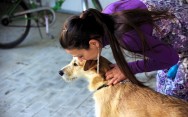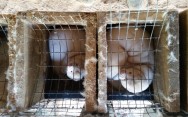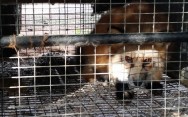Blog Archives
Home -
Archive by category "Animal rights" (Page 9)
The USDA have been silently slaughtering kittens for years. We know this because of Freedom of Information Act requests made by White Coat Waste Project that revealed the slaughter. After White Coat Waste Project noticed a casual reference on the website to kittens at the Beltsville Agricultural Center Research facility, they requested information from the USDA showing that the kittens have been used in experiments for years and then incinerated.
It’s not just that the kittens died – lives casually thrown away year after year – but the ordeal these animals had to go through before they died. During the course of the experiments, the kittens were force-fed raw meat so their feces could be inspected for parasites. It’s not clear how this affected the health of the animals, but they were clearly deemed unfit to be rehabilitated. Did they receive care after these experiments? The USDA has refused to comply with the most recent FOIA request, so White Coat Waste Project is suing them.
The USDA is the body responsible for setting standards and holding agriculture accountable. Their casual hypocrisy on this matter is unconscionable. Please read more about this horrific cover-up, share on social media and sign the petition.
https://petitions.whitecoatwaste.org/sue-usda/?pid=6879934&utm_source=email&utm_campaign=usda_lawsuit&utm_medium=hf&red=caged-kittens-2%2f%3finitiativekey%3dXAPAAAVEGSKG
https://www.cnn.com/2018/09/07/politics/usda-cat-experiments/index.html
If you care about animal rights, you might have countless petitions arriving in your inbox alerting you to the tragedy of kill shelters (that is shelters that euthanize animals they can’t find a home for). You could react by being outraged or you could stop to see a broader pattern.
Some shelters have a higher kill rate than others, such as this one at Randolph County, NC. There are usually several reasons for this – but one major reason is lack of money. Animal shelters just can’t handle the high volume of stray animals they accommodate. The aim is not to name and shame, the aim is to support and reform.
A very simple way of making a difference is to find out more about animal shelters near you and see what you can do. Do they have a high kill rate? Do they suffer from a lack of funding? Could more be done to connect animals with new owners via advertising, social media etc.?
You can volunteer for these shelters, support them financially and hold them accountable for their practices. By doing this you’ll be saving the lives of healthy, loving animals who deserve a chance at a new life.
The USA’s biggest economy just aimed right at the heart of cruel testing on animals. The California Cruelty-Free Cosmetics Act SB-1249 passed after an 80-0 vote. This is a major victory for animals and its effects should have an influence far beyond California itself. The law doesn’t just outlaw cosmetics tested on animals, it bans cosmetics containing any components tested on animals. As California is such a huge market (in fact recently listed as the 5th biggest economy in the world), it should encourage better practices the world over.
A lot of people still believe that testing on animals is for “the greater good”, but science and technology have increasingly shown we can use alternative methods. Please read more about this topic and spread the word that animal testing is unnecessary and cruel!
The Bureau of Land Management’s brutal sterilization program for wild horses should not be allowed to take place. The plan calls for the least safe and most invasive method of sterilizing wild horses – even though controlling wild populations is already legally suspect (according to this op-ed).
The sterilization could hardly be called a procedure, as it involves vets literally reaching inside female horses for their ovaries and removing them right there on the spot. Without follow-up, a plan for administering antibiotics, pain relief, or a period of care, horses could hemorrhage or get sepsis and die out in the wild.
The BLM is ignoring other alternatives that could be safer, because of so-called cost, even though the scale of this sterilization program would be massive (and therefore costly) as well as the huge risk of failure. If the program is doomed to fail, it’s been suggested, it would be easier to justify mass cullings of horses by offering the excuse that other alternatives have failed. There is something callous and cynical about the sudden leap to board a large scale program that is not strongly backed by experts, that puts horses through so much unnecessary damage – without even giving pain relief.
Brutality is often justified by “necessity”. This program is crude, unnecessary and incredibly harmful to horses. Please sign the petition and share to protect wild horses.
A heartbreaking story about an orca whale who mourned her dead calf has the public thinking about Lolita, the captive orca whale again.
And as Lolita reaches retirement, this time it could really make a difference – not only to her, but to her endangered family as well.
Protests have come and gone after years of campaigning to free the lonely orca who occupies a tank that is much too small for her. Lolita lost her mate several years ago and spends much of the time floating, in a listless trance.
What inspired the wake-up call this time was a story about a Southern Resident Killer Whale from Lolita’s orca whale clan. The female whale, called Tahlequah, carried her dead calf with her for 17 days across hundreds of miles, refusing to let go. Some believe this was a deliberate act of mourning, like a funeral. The story has made an impression on how people think about the emotional ties between orcas. This is important for Lolita as there are doubts over whether she will be reunited with her family when she retires, who she hasn’t seen for 47 years. Lolita still sings the songs of her Pod. At 50 years old she has spent most of her life in captivity.
Thinking about Lolita in the context of her family is really important, even if Lolita is never reunited with them. Lolita comes from a population of whales called the Southern Resident Killer Whales. After a brutal roundup in the 70s, baby whales, including Lolita, were separated from their distraught parents and taken to various entertainment parks around the country. Orca whale society is matrilineal and orca whales stay with their mothers their whole lives. Lolita has been in captivity a very long time, so there are questions over whether she would reintegrate successfully with her family, and genuine concerns about her carrying a pathogen that would harm her family. On the other hand, the closeness and deep emotional ties of orca whale society make it heartbreaking that Lolita would never return home.
Thinking about what home means for a captive whale like Lolita means we can’t ignore the fact that Lolita’s family is under threat. We as humans owe a debt to this animal population and culture, that we have stressed, threatened and dispersed. After the Southern Resident Killer Whale population were terrorized and brutalized in the 70s, their population never recovered, and their endangered species designation doesn’t do enough to protect them. It has done nothing to maintain a food source for them, for one. These whales are literally starving due to a lack of their natural food, the Chinook salmon (which is also endangered). A system of dams keeps the orcas from their food. Orca whales have been giving birth to calves who don’t survive, and all pregnancies in the last three years have failed. This doesn’t even take into account pollution and disruption from boat traffic. There are proposals to free up food sources at some of the dams, but these are moving too slowly.
We must act now to protect Lolita’s family, and to ask that genuine efforts are made to return her home where she belongs. Lolita’s freedom and our attention on this issue is nothing less than an act of atonement.
Please read, share/sign and donate.
Read More:
https://blogs.scientificamerican.com/observations/free-lolita-the-killer-whale/
https://www.miamiherald.com/news/business/article185517463.html
https://www.nrdc.org/experts/giulia-cs-good-stefani/penn-cove-captures-why-southern-resident-orcas-need-us
https://www.care2.com/causes/grieving-mother-orca-carried-her-dead-calf-for-17-days.html
Ghetto Rescue took one last video of Valerie the pitbull before she died, and it is heartbreaking. A blue-grey pitbull with a beautiful lustrous coat, she’s lying on the ground being reassured by the humans around her, as the life is ebbing out of her.
Ghetto Rescue found Valerie in South Los Angeles after she was dumped out of a car. They claim she was sexually assaulted, although her death seems to have been the result of trauma to her chest. The LAPD are investigating the case for bestiality and animal cruelty, and treating the sexual assault just as if it was a human rape (testing for DNA). The difference is however, that the rape is considered “bestiality” and is a misdemeanor rather than felony.
It’s reassuring to hear reports of the police going about their business in a thorough way, just as if Valerie was a human. The police started the investigation based on the posts of Ghetto Rescue. Still, Valerie’s abuse will have to be treated within the capacity of the law, which might not be enough to hold her abusers accountable. The sad thing is that this beautiful pitbull lost her life even though she was a shelter animal. Her chance for a new life ended tragically. Animals like Valerie are vulnerable to abuse, and protecting them ends up being a band-aid once they are seriously injured or traumatized. Rather than comforting them when they are dying, we need to take steps to protect them in life.
https://www.ocregister.com/2018/08/09/lapd-investigating-alleged-trauma-sexual-assault-of-pit-bull-found-in-south-los-angeles-area/
Just as the world’s most recent ape species was discovered, their habitat is about to be decimated. The Northern Sumatran Tanpanuli Orangutan was only discovered last year, and the population is already known to be the most endangered ape species in the world. The orangutans are threatened by Chinese diggers constructing a hydroelectric dam that will divide their habitat in two.
The dam has been opposed by leading environmentalists. Research in top scientific journals has shown that its impact will be disastrous. Yet it still goes ahead because of an injection of funding from the Chinese State Bank. Other major funders have pulled money based on the impacts on the orangutans, amongst other things. The reason why this disastrous project is being protected is that it is part of a huge Chinese plan for infrastructure to facilitate trade. Projects like this will spring up elsewhere, harming other wildlife.
Videos show orangutans clawing at diggers who are moving into their habitat. Orangutan literally means “man of the forest.” We must stop the advance of human works of such magnitude and harm. The vulnerable are counting on us. Please sign and share.
See Also:
https://news.mongabay.com/2018/07/scientists-urge-indonesian-president-to-nix-dam-in-orangutan-habitat/
https://www.theguardian.com/environment/radical-conservation/2018/apr/23/worlds-newest-great-ape-threatened-by-chinese-dam
The couple who captured footage of closely packed together pigs did so on a casual detour. They had no idea they were exposing Canada’s animal outdated transportation conditions, they just noticed the animals were in discomfort and started filming.
In Canada, pigs can be trucked for up to 36 hours without a break for rest, food or water, compared to 8 hours in the European Union. These outdated laws are due for a change but no one has been paying attention.
Sometimes all it takes is a little push. The video is steadily gaining views. A recent Vancouver Sun story showed that 46 pigs had died being shipped from Alberta to Donald’s Fine Foods in Langley. Phone video footage is a small weapon which can have a huge impact, and thankfully it is easily accessible to most people. Please share the news and remember you can use your phone to pay attention to the conditions around you. You never know, it could save animal lives!
See the original article for details: https://www.kamloopsmatters.com/local-news/video-by-kamloops-animal-rights-group-prompts-investigation-984692
This last week, the world has been in mourning for Koko the beloved mountain gorilla who learned to speak in American sign language. Koko was born on the 4th of July 1971, hence her name “Fireworks-child” (in Japanese), shortened to “Koko.” This fireworks child was a prodigy – she learned to play the recorder, and to sign over 1,000 signs and understand 2,000 words of spoken English. Koko was sad when she lost a pet, spoke about her longing for a child (the pet kitten was a close substitute) and talked about death and her own death. She also played with words and mixed them up in new combinations. She once described herself as a “fine-gorilla-person.”
Did humans teach Koko about language, or did Koko teach humans? Koko could speak in sign language,
but also more importantly, she could listen. When she listened, she interpreted things in her own way.
Despite criticism of the Koko project (which stated that Koko was mimicking her trainers), Koko
responded in unexpected ways. When she was asked where gorillas go to when they die, she said
“comfortable-hole-bye.” There were a few occasions when she expressed deep sadness and grief, like
when her pet kitten was hit by a car and killed.
Language is often used as an excuse to elevate humans above other animals. There were scientists who
felt Koko’s use of language was meaningless, as she didn’t learn grammar and syntax. But throughout
her life, Koko used sign language not as a lifeless toy or tool to get food and water, but a way to
communicate and describe her world. Communication –- rather than language –- was the key. Koko
and her researchers built a rapport together, where words could mean more than the dictionary
definition, they could mean complex emotional states and refer to shared understanding between
Koko and the researchers. Above all, what Koko taught us is that language is a human invention, but
communication is common to all animals. For that, we owe a debt to Koko, our Gorilla teacher.
The group that came to the rescue of baby elephant Suman have released a video showing the elephant’s captor inflicting relentless violence on elephants. Wildlife SOS launched a campaign to save Suman the baby elephant, but still nothing has been done by the Rajasthan government, despite the fact that elephant trafficking is illegal.
The baby elephant was already in a delicate state when evidence of her captivity drew outrage. She was penned in a small cage, tied by her foot and making repetitive movements that clearly showed distress. Her parents and sister have since been reunited, but this six year old baby elephant is still at the mercy of almost certain violence, abuse and mistreatment. In the video her captor is shown mercilessly beating and tying up and burning the foot-pads of elephants. Humans who protested have also reportedly been fired or attacked.
Animal psychologists are worried about the damage this trauma will do to Suman. Elephants live just as long as humans and so the “memory of an elephant” could be a liability as well as a gift. The sooner the baby elephant can be freed, the more likely she is to heal from the harm and isolation done to her.
Please donate, share and sign Wildlife SOS’s petition: http://wildlifesos.org/save-suman/?gclid=EAIaIQobChMIsfTDgqTU2wIVTbnACh0VLgMOEAAYASAAEgIQ8PD_BwE
More Info on this story:
http://www.newindianexpress.com/nation/2018/jun/07/rajasthan-government-slammed-for-failing-to-take-action-against-owner-who-tortured-baby-elephant-1824676.html
http://www.dailymail.co.uk/news/article-5835245/Shocking-video-shows-Indian-trafficker-mercilessly-beat-burn-elephant.html
http://www.timesnownews.com/mirror-now/society/article/shocking-visual-of-merciless-trafficker-torturing-elephants-in-jaipur-goes-viral/239966








Social Media